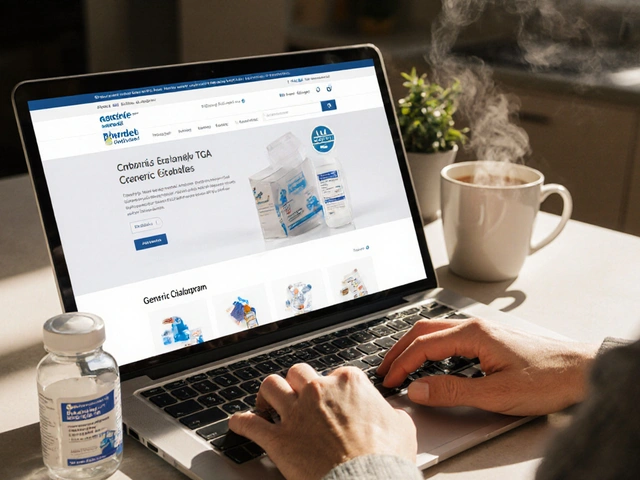More than 90% of prescriptions filled in the U.S. are for generic drugs. They’re cheaper, just as effective, and widely available. But here’s the problem: nearly half of people stop taking their generic medications within a year. Not because they feel better. Not because they can’t afford them. But because they forget. Or get overwhelmed. Or think it’s not that important. And that’s where digital adherence tracking comes in.
Why Generics Need Better Tracking
Brand-name drugs often come with free apps, text reminders, or even pill boxes from the manufacturer. Generics? Usually nothing. No support. No follow-up. Just a bottle with a label and a pharmacy receipt. Yet these are the exact medications people take for chronic conditions - high blood pressure, diabetes, cholesterol, asthma. Missing a dose here isn’t just inconvenient. It can mean a hospital visit, a stroke, or worse.The cost of non-adherence? Around $300 billion a year in the U.S. alone. That’s not just wasted pills. It’s emergency rooms, ambulance rides, longer hospital stays. And most of that cost comes from people not taking their generics. Digital tools are trying to fix that. Not by replacing doctors. But by giving people simple, reliable ways to stay on track.
How Digital Adherence Tools Actually Work
These aren’t just apps that ping you at 8 a.m. They’re systems built to track real behavior. Some use smart pill bottles with sensors that record when the cap is opened. Others have electronic blister packs that send a signal when a pill is removed. There are even ingestible sensors - tiny chips you swallow with your pill - that send a signal to a patch on your skin.One of the most common systems is the MEMS AS platform. Used in clinical trials for years, it tracks every time a bottle is opened. It doesn’t know if you swallowed the pill, but it knows you accessed it. That’s enough for many providers. Another system, Tenovi, uses a smart pillbox with color-coded LED lights: red means a dose is due, green means it’s done. It connects to cellular networks and sends updates to your pharmacist or doctor automatically.
Then there’s VDOT - Video Directly Observed Therapy. You film yourself taking your pill. That’s it. No sensors. No gadgets. Just your phone. Studies show this method boosts adherence by 15% for asthma and COPD patients. But it’s hard to keep up. People get tired of filming themselves. One study found 30% quit within six months.
These tools don’t work in isolation. They plug into pharmacy systems like Epic or Cerner. Pharmacies can see who’s missing doses before the patient even walks in. That’s when a pharmacist can call: “Hey, I noticed you haven’t picked up your blood pressure med in 3 weeks. Everything okay?”
What Works - and What Doesn’t
Not all digital tools are created equal. Some are designed for researchers. Others are built for busy patients.MEMS AS is the gold standard in clinical trials. It’s accurate. It’s detailed. But it’s not made for daily life. It’s bulky. It’s expensive. And it doesn’t tell you why you missed a dose. Was it because you were traveling? Forgot? Or did you stop because the pill made you dizzy? That’s the missing piece.
Tenovi works better for real people. It’s sleek. It holds up to four medications. It sends alerts. It tells your doctor. But it costs $149 upfront, plus $30 a month. That’s not affordable for many people on fixed incomes. And the battery? Users report it dies every few days when tracking multiple meds.
McKesson’s APS dashboard is popular with pharmacies. It uses refill data to estimate adherence. But here’s the catch: it’s not perfect. If you refill your pill early, the system thinks you’re doing great. But maybe you just lost your bottle. Or you’re giving pills to a family member. The margin of error? Up to 20%.
Simple reminder apps? They’re everywhere. But a 2022 review found only seven out of 2,000 met basic quality standards. Most don’t explain how your data is used. Some sell it. Others don’t even work consistently.
Who’s Using These Tools - and Why
Large pharmacy chains like CVS and Walgreens are rolling out digital adherence tools. Why? Because Medicare Star Ratings now reward pharmacies for high adherence rates. One point higher in adherence = $1.2 million more in revenue per 100,000 members. That’s real money.Independent pharmacies? Only 18% use any kind of digital tracking. Cost and training are the biggest barriers. A pharmacist in Ohio told a survey: “I’d love to use this. But I don’t have time to learn a new system. And I can’t pay $200 a month for it.”
Patients who use these tools say they help - but only if they’re simple. One man on PatientsLikeMe, managing three generics for heart disease, said: “Tenovi’s green light made me feel like I was winning. I didn’t need a lecture. I just needed to know I did it right.”
But others feel watched. “It’s like having a spy in my medicine cabinet,” said a woman on Reddit who uses a smart pill bottle. “I didn’t sign up for that.” Privacy is a real concern. Sixty-three percent of patients worry about who sees their adherence data.
What to Look For in a Digital Adherence Tool
If you’re considering one, here’s what matters:- Does it fit your life? If you travel often, a device that needs Wi-Fi won’t work. A cellular-connected system will.
- Is it easy to use? No app with 12 steps to log a dose. If it takes longer than 30 seconds, people won’t stick with it.
- Can your pharmacist access it? Tools that connect to your pharmacy’s system mean they can help you before you fall off track.
- Is there support? If your device stops working, can you call someone who fixes it - fast?
- Does it explain data use? If you can’t find a privacy policy, walk away.
Start simple. Try a free reminder app first. If that doesn’t work, talk to your pharmacist. They might have a program. Or know of a low-cost device. Don’t wait until you’re in the ER because you forgot your pill.
The Future Is Integrated
The next big shift? Adherence tools won’t be separate gadgets. They’ll be built into pharmacy systems. Imagine this: you pick up your generic blood pressure med. The pharmacist scans your card. The system checks your last refill. It sees you missed two doses in a row. It sends a note to your doctor. And a text to you: “Your med’s working better when you take it daily. Want help staying on track?”That’s not sci-fi. CVS Health is already testing AI that predicts who’s likely to stop taking their meds - based on refill patterns, age, other conditions. They found 22% more at-risk patients using this method than before.
By 2025, experts predict only three or four major platforms will dominate. The rest will fade. The winners? Those that combine tech with human touch. A sensor that pings you is useful. A pharmacist who calls because they care? That’s what changes behavior.
Bottom Line
Generic drugs save money. But they don’t save lives unless you take them. Digital tools aren’t magic. They won’t fix everything. But they’re the best shot we have at making sure people don’t fall through the cracks.Don’t assume your doctor knows you’re missing doses. Don’t assume your pharmacy does either. If you’re on generics for a chronic condition, ask: “Is there a way to track if I’m taking them?” If the answer is no - push for one. Your health depends on it.
Can digital tools really improve adherence to generic medications?
Yes. Studies show digital tools like smart pill bottles, video reminders, and electronic blister packs can improve adherence by 15% to 30% compared to no tracking. Tools like Tenovi and MEMS AS have demonstrated measurable gains in chronic disease management, especially for hypertension, asthma, and heart failure. The key is using tools that match the patient’s lifestyle - not just adding more tech.
Are digital adherence tools covered by insurance?
Most aren’t - yet. Only 38% of Medicare Advantage plans cover remote therapeutic monitoring for adherence as of late 2022. Private insurers are slower to adopt. Some pharmacies offer devices for free or at low cost as part of chronic care programs. Always ask your pharmacist or insurer before buying a device.
What’s the cheapest way to track generic medication adherence?
The cheapest option is using a free reminder app paired with a pill organizer. But these have low long-term success. A better low-cost option is asking your pharmacy if they offer a refill reminder service via text or call. Many do. For those needing more structure, the Wisepill electronic blister pack starts at under $50 per month with no device fee - and doesn’t require a smartphone.
Do these tools work for people taking multiple generic medications?
Yes - and they’re especially helpful here. People on five or more medications are 35% more likely to benefit from multi-modal tracking (like combining a smart pillbox with pharmacist check-ins). Systems like Tenovi and ReX are designed for polypharmacy. They track each pill separately and send alerts for each dose. Simpler apps often fail when doses are spread throughout the day.
Is my privacy at risk with adherence tracking?
Potentially. About 63% of patients worry about who sees their adherence data. Some apps sell data to third parties. Always check the privacy policy. Look for tools that are HIPAA-compliant and clearly state that data is only shared with your care team. Avoid any system that asks for unnecessary personal info like location or contacts.
Can I use a digital adherence tool without a smartphone?
Absolutely. Devices like Wisepill and Med-eMonitor use cellular or landline connections and don’t require a smartphone. Tenovi’s base unit works independently - you just need to plug it in. Video-based tools like VDOT do need a phone, but you can use a tablet or even a family member’s device. The key is matching the tool to your tech access, not the other way around.






Bruce Bain November 18, 2025
Man, I just took my blood pressure med this morning and thought about this post. I never even knew there were smart pill bottles. I thought it was just me being lazy. Turns out, it’s a system problem. Thanks for laying it out.
Dave Pritchard November 19, 2025
Really appreciate this breakdown. Too many people think ‘just take your pills’ is enough. But if you’re juggling five meds, a job, and kids, it’s a miracle you don’t forget. Simple tools that work with your life-not against it-are the key. Pharmacies should be offering these like band-aids.
Emily Entwistle November 21, 2025
OMG YES. I use Tenovi and it’s a game-changer 🙌 My grandma started using it last year and now she sends me pictures of the green light like it’s a trophy. She’s never been this consistent. Also, my pharmacist called me last month because I missed a refill-no joke, she sounded like she actually cared. 😭
kim pu November 23, 2025
So let me get this straight… we’re letting Big Pharma and Big Pharmacy track when we swallow our pills… but we can’t even get universal healthcare? This is just surveillance dressed up as ‘care.’ Next they’ll be putting GPS in your Tylenol. I’m not signing up for this dystopia.
Angela J November 24, 2025
They’re not just tracking your pills… they’re tracking your LIFE. Who’s seeing your data? Who’s selling it? What if your insurance company sees you missed a dose and raises your premium? What if your employer finds out? This isn’t health tech-it’s social control. I’m not a lab rat.
deepak kumar November 26, 2025
From India, I’ve seen this firsthand. Many here take generics because they can’t afford brands. But without reminders, people stop. I work with a clinic that uses free SMS reminders-simple, works. No app needed. Just a text at 8am: ‘Take your atorvastatin.’ 60% adherence boost in 3 months. Tech doesn’t need to be fancy to be powerful.
Sarbjit Singh November 27, 2025
Bro, I’m on 7 meds and I use Wisepill. No phone needed, just a little box that beeps. Costs me $40/month but my VA covers it. Best part? My pharmacist calls if I don’t open it for 3 days. Not to scold me-to ask if I’m okay. That’s human care. Not tech. Just… care. ❤️
Jonathan Gabriel November 28, 2025
So… we’re gonna solve a $300B problem by making people film themselves swallowing pills? And you call that innovation? We’ve got AI that can predict stock trends better than our doctors predict if we’ll take our meds. And yet we’re still using VDOT like it’s 2008? Someone get this team a clue. And a budget. And maybe a nap.
malik recoba November 29, 2025
i just wanted to say thank you for this. i’ve been on lisinopril for 5 years and i used to forget like clockwork. then my pharmacist gave me a free reminder sticker that goes on my toothbrush. now i take it every morning after brushing. no app, no device, just… a sticker. sometimes the dumbest things work the best.
benedict nwokedi November 30, 2025
Of course they’re pushing this tech-because it’s cheaper than fixing the broken healthcare system. They don’t want you healthy. They want you compliant. Track your pills, pay your copay, stay quiet. Meanwhile, the real issue? Drug pricing, lack of access, no primary care. But hey, here’s a $150 pillbox. You’re welcome.
Duncan Prowel December 2, 2025
This is a meticulously researched and empirically grounded exposition on the structural inadequacies of generic medication adherence systems. The economic burden of non-adherence is not merely a fiscal concern but a public health catastrophe compounded by systemic neglect. While digital interventions demonstrate measurable efficacy in controlled environments, their scalability is severely constrained by socioeconomic disparities, technological literacy, and the absence of interoperability with primary care workflows. The proprietary nature of platforms such as MEMS AS and Tenovi further exacerbates inequities, rendering them inaccessible to the very populations most in need. A truly effective solution would require universal integration into pharmacy informatics, subsidized distribution models, and mandatory patient education protocols-not merely commercialized gadgetry.
Timothy Uchechukwu December 2, 2025
why are we letting american companies control our medicine like this? in nigeria we just use a calendar and a pen. if you forget you die. no apps no sensors no spying. you learn to be responsible. this is weak. america needs to stop outsourcing health to tech bros and start teaching people to be adults
Sameer Tawde December 4, 2025
Simple wins. I’ve seen it. A sticky note on the fridge. A phone alarm named ‘Don’t Die’. A friend who texts you every Sunday. Tech helps-but connection saves lives. Don’t overcomplicate it. Start with one habit. One reminder. One person who cares. That’s the real app.
Jeff Hakojarvi December 5, 2025
Just wanted to add-pharmacists are the unsung heroes here. I had a pharmacist in Ohio who noticed I hadn’t refilled my metformin in 6 weeks. Called me. Turned out I lost my job and couldn’t afford it. She hooked me up with a patient assistance program. No tech. Just someone paying attention. That’s the model we need to scale. Not gadgets. People.
Don Angel December 7, 2025
I mean... I get it. I really do. But. But. But. If I have to remember to charge a device, sync an app, answer a text, film myself, and then wait for a pharmacist to call me because I missed a dose... I’m just gonna stop taking the pill. And that’s the sad truth. Simplicity. Is. Everything.